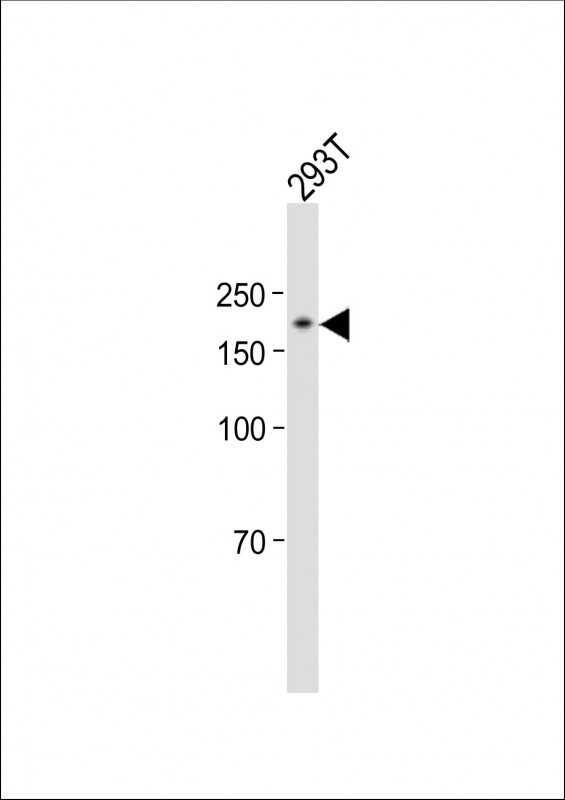RB1CC1 Antibody (Center)
Affinity Purified Rabbit Polyclonal Antibody (Pab)
- 产品详情
- 实验流程
- 背景知识
Application
| WB, E |
|---|---|
| Primary Accession | Q8TDY2 |
| Other Accession | Q9ESK9, NP_001077086.1, NP_055596.3 |
| Reactivity | Mouse |
| Host | Rabbit |
| Clonality | Polyclonal |
| Isotype | Rabbit IgG |
| Calculated MW | 183091 Da |
| Antigen Region | 489-515 aa |
| Gene ID | 9821 |
|---|---|
| Other Names | RB1-inducible coiled-coil protein 1, FAK family kinase-interacting protein of 200 kDa, FIP200, RB1CC1, KIAA0203, RBICC |
| Target/Specificity | This RB1CC1 antibody is generated from rabbits immunized with a KLH conjugated synthetic peptide between 489-515 amino acids from the Central region of human RB1CC1. |
| Dilution | WB~~1:1000 E~~Use at an assay dependent concentration. |
| Format | Purified polyclonal antibody supplied in PBS with 0.05% (V/V) Proclin 300. This antibody is prepared by Saturated Ammonium Sulfate (SAS) precipitation followed by dialysis against PBS. |
| Storage | Maintain refrigerated at 2-8°C for up to 2 weeks. For long term storage store at -20°C in small aliquots to prevent freeze-thaw cycles. |
| Precautions | RB1CC1 Antibody (Center) is for research use only and not for use in diagnostic or therapeutic procedures. |
| Name | RB1CC1 (HGNC:15574) |
|---|---|
| Synonyms | KIAA0203, RBICC |
| Function | Involved in autophagy (PubMed:21775823). Regulates early events but also late events of autophagosome formation through direct interaction with Atg16L1 (PubMed:23392225). Required for the formation of the autophagosome-like double-membrane structure that surrounds the Salmonella-containing vacuole (SCV) during S.typhimurium infection and subsequent xenophagy (By similarity). Involved in repair of DNA damage caused by ionizing radiation, which subsequently improves cell survival by decreasing apoptosis (By similarity). Inhibits PTK2/FAK1 and PTK2B/PYK2 kinase activity, affecting their downstream signaling pathways (PubMed:10769033, PubMed:12221124). Plays a role as a modulator of TGF-beta-signaling by restricting substrate specificity of RNF111 (By similarity). Functions as a DNA-binding transcription factor (PubMed:12095676). Is a potent regulator of the RB1 pathway through induction of RB1 expression (PubMed:14533007). Plays a crucial role in muscular differentiation (PubMed:12163359). Plays an indispensable role in fetal hematopoiesis and in the regulation of neuronal homeostasis (By similarity). |
| Cellular Location | Nucleus. Cytoplasm. Cytoplasm, cytosol {ECO:0000250|UniProtKB:Q9ESK9}. Preautophagosomal structure. Lysosome Note=Under starvation conditions, is localized to puncate structures primarily representing the isolation membrane that sequesters a portion of the cytoplasm resulting in the formation of an autophagosome |
| Tissue Location | Expression levels correlated closely with those of RB1 in cancer cell lines as well as in various normal human tissues Abundantly expressed in human musculoskeletal and cultured osteosarcoma cells. |
For Research Use Only. Not For Use In Diagnostic Procedures.
Provided below are standard protocols that you may find useful for product applications.
BACKGROUND
The protein encoded by this gene interacts with signaling pathways to coordinately regulate cell growth, cell proliferation, apoptosis, autophagy, and cell migration. This tumor suppressor also enhances retinoblastoma 1 gene expression in cancer cells. Alternative splicing results in multiple transcript variants encoding distinct isoforms.
REFERENCES
Liu, C.Y., et al. Carcinogenesis 31(7):1259-1263(2010)
Guey, L.T., et al. Eur. Urol. 57(2):283-292(2010)
Chano, T., et al. PLoS ONE 5 (6), E11404 (2010) :
Paun, B.C., et al. PLoS ONE 4 (11), E7715 (2009) :
Chan, E.Y. Sci Signal 2 (84), PE51 (2009) :
终于等到您。ABCEPTA(百远生物)抗体产品。
点击下方“我要评价 ”按钮提交您的反馈信息,您的反馈和评价是我们最宝贵的财富之一,
我们将在1-3个工作日内处理您的反馈信息。
如有疑问,联系:0512-88856768 tech-china@abcepta.com.























 癌症的基本特征包括细胞增殖、血管生成、迁移、凋亡逃避机制和细胞永生等。找到癌症发生过程中这些通路的关键标记物和对应的抗体用于检测至关重要。
癌症的基本特征包括细胞增殖、血管生成、迁移、凋亡逃避机制和细胞永生等。找到癌症发生过程中这些通路的关键标记物和对应的抗体用于检测至关重要。 为您推荐一个泛素化位点预测神器——泛素化分析工具,可以为您的蛋白的泛素化位点作出预测和评分。
为您推荐一个泛素化位点预测神器——泛素化分析工具,可以为您的蛋白的泛素化位点作出预测和评分。 细胞自噬受体图形绘图工具为你的蛋白的细胞受体结合位点作出预测和评分,识别结合到自噬通路中的蛋白是非常重要的,便于让我们理解自噬在正常生理、病理过程中的作用,如发育、细胞分化、神经退化性疾病、压力条件下、感染和癌症。
细胞自噬受体图形绘图工具为你的蛋白的细胞受体结合位点作出预测和评分,识别结合到自噬通路中的蛋白是非常重要的,便于让我们理解自噬在正常生理、病理过程中的作用,如发育、细胞分化、神经退化性疾病、压力条件下、感染和癌症。






